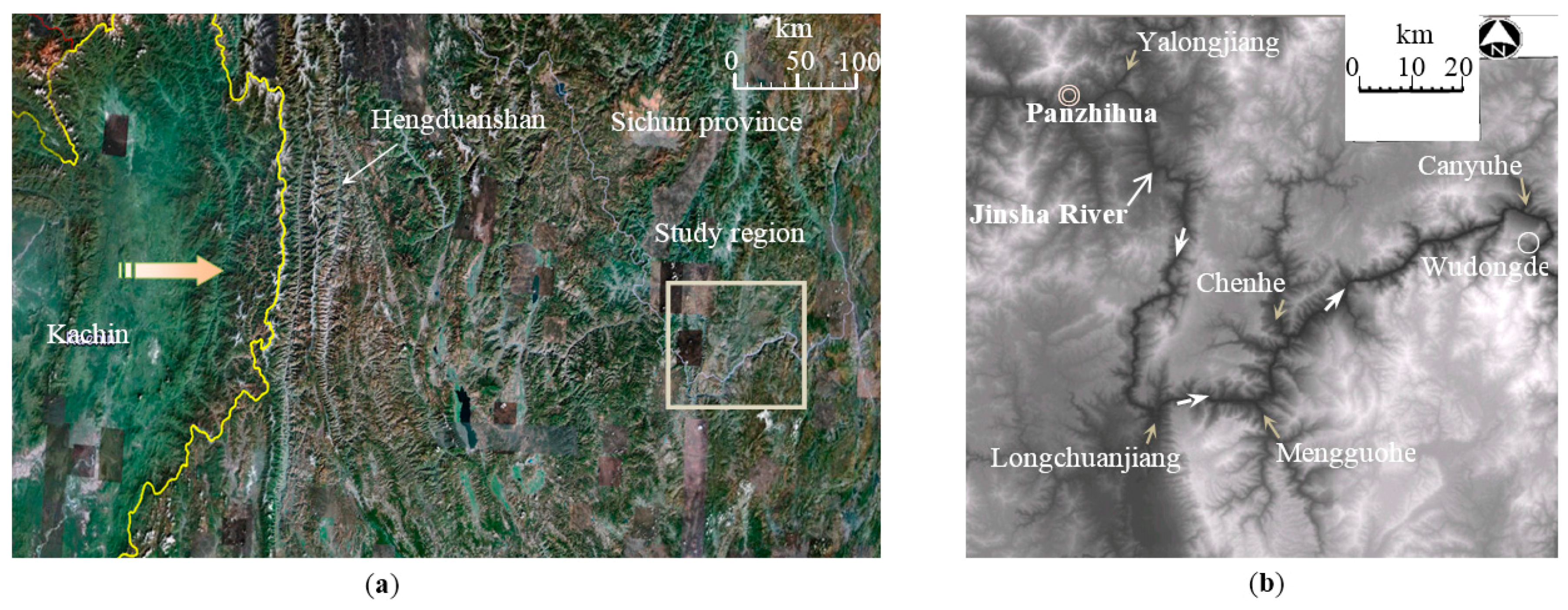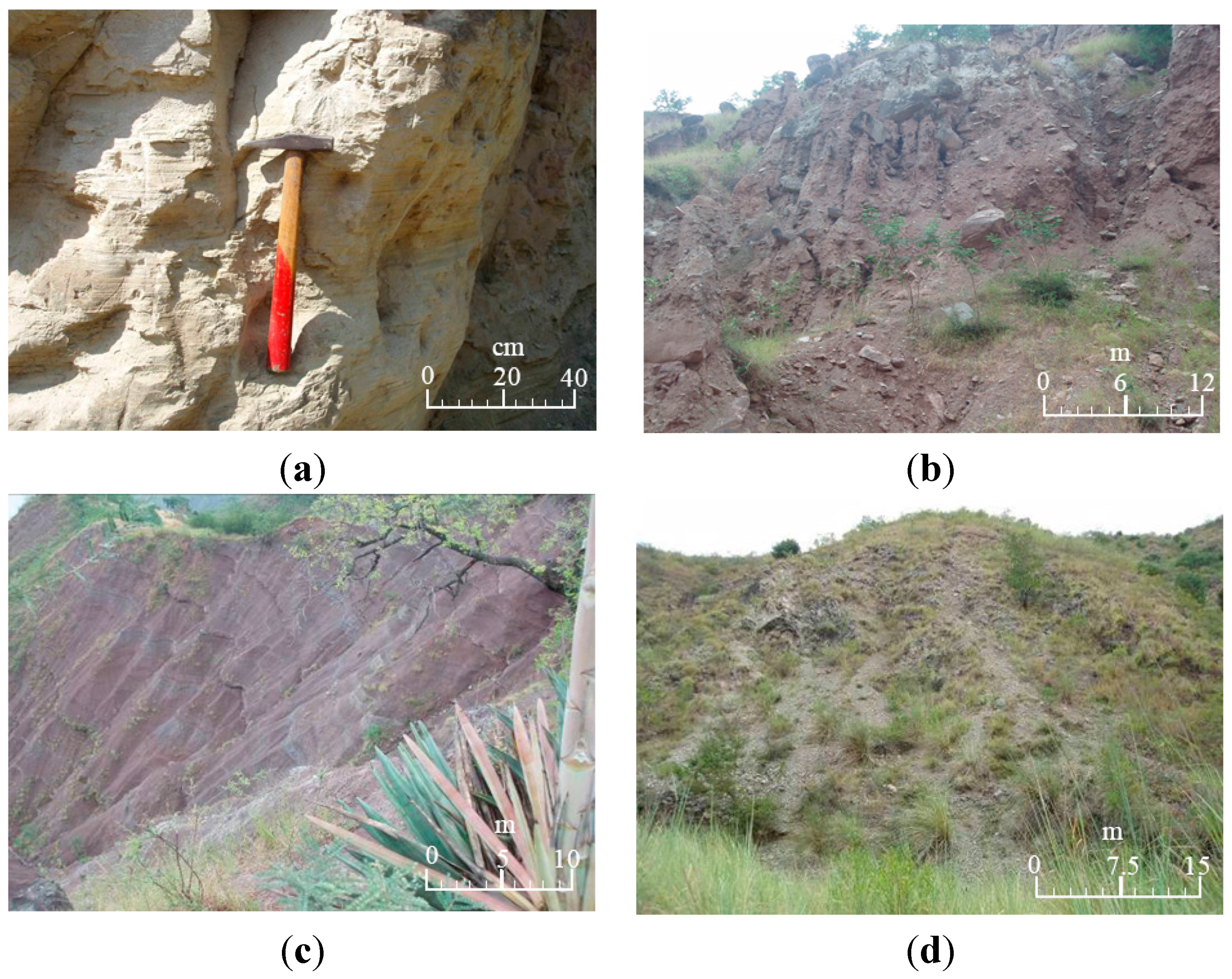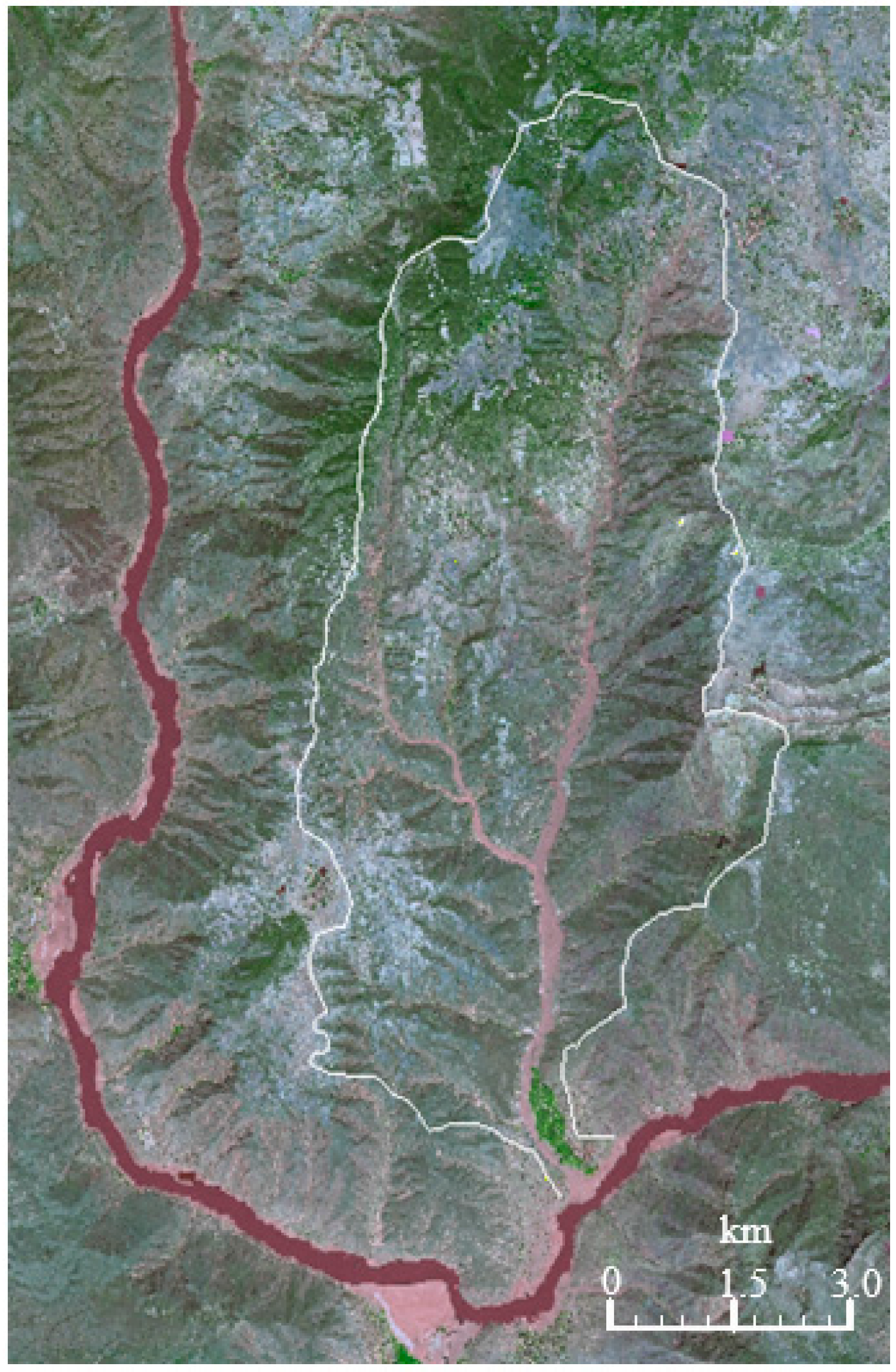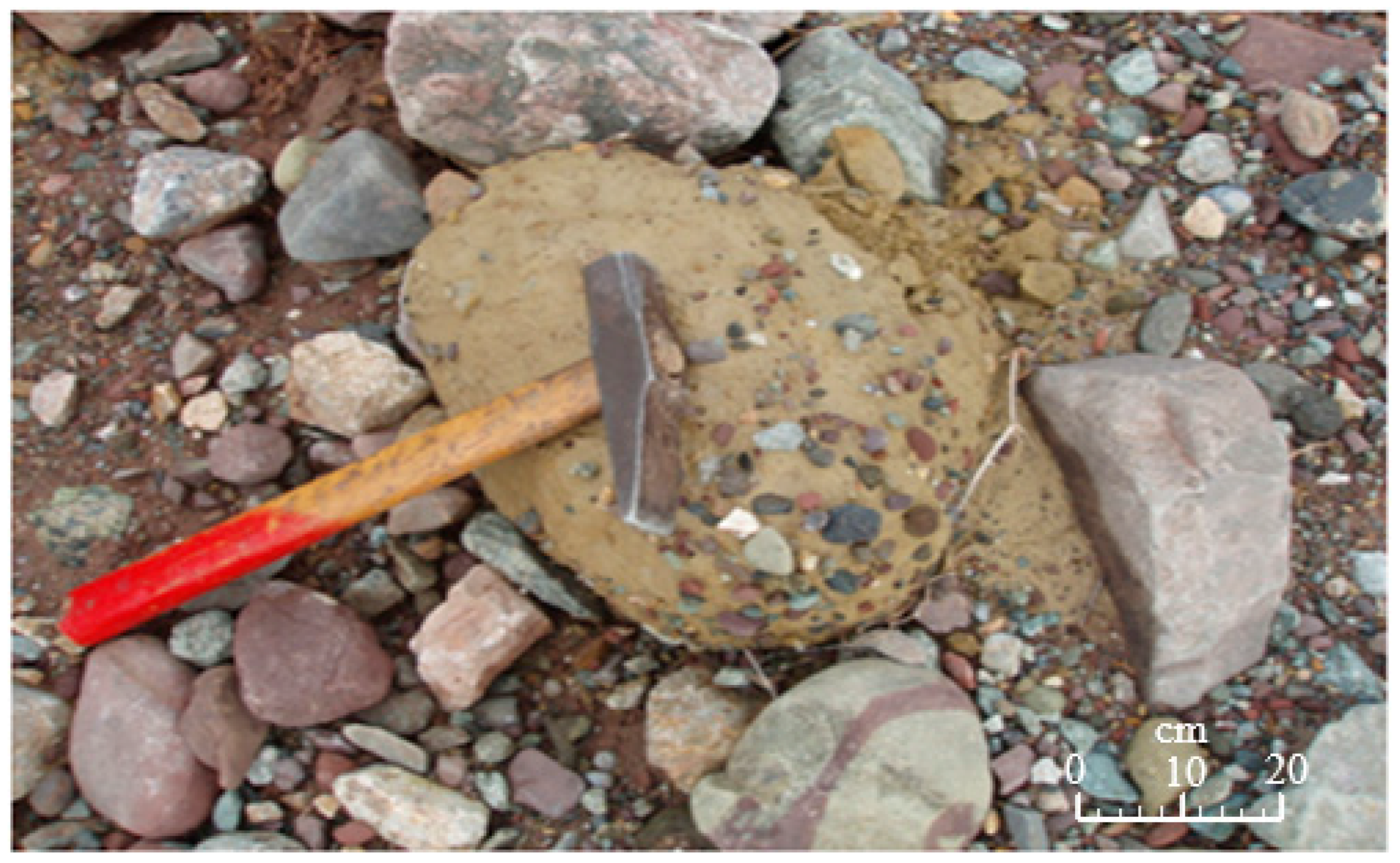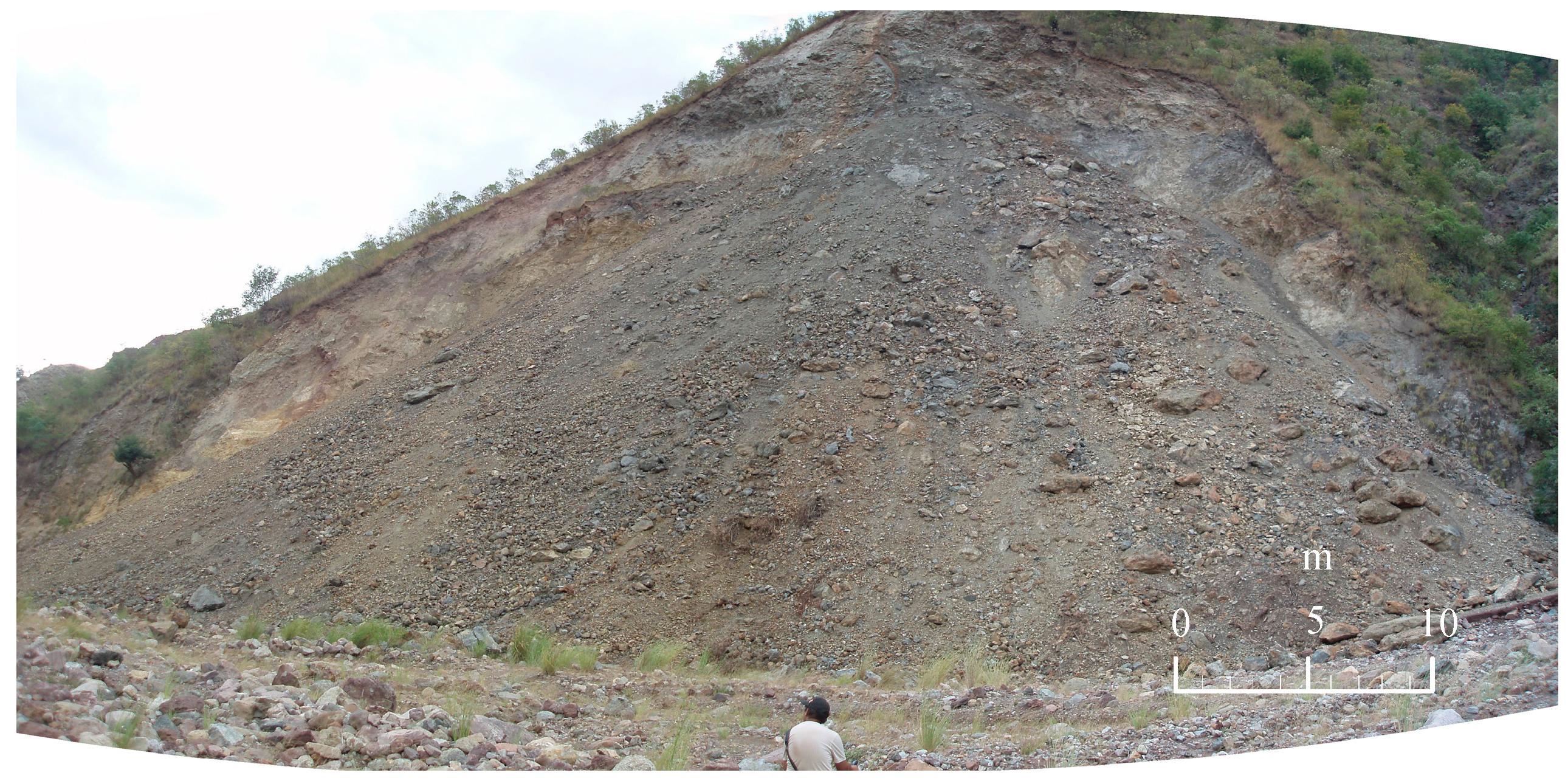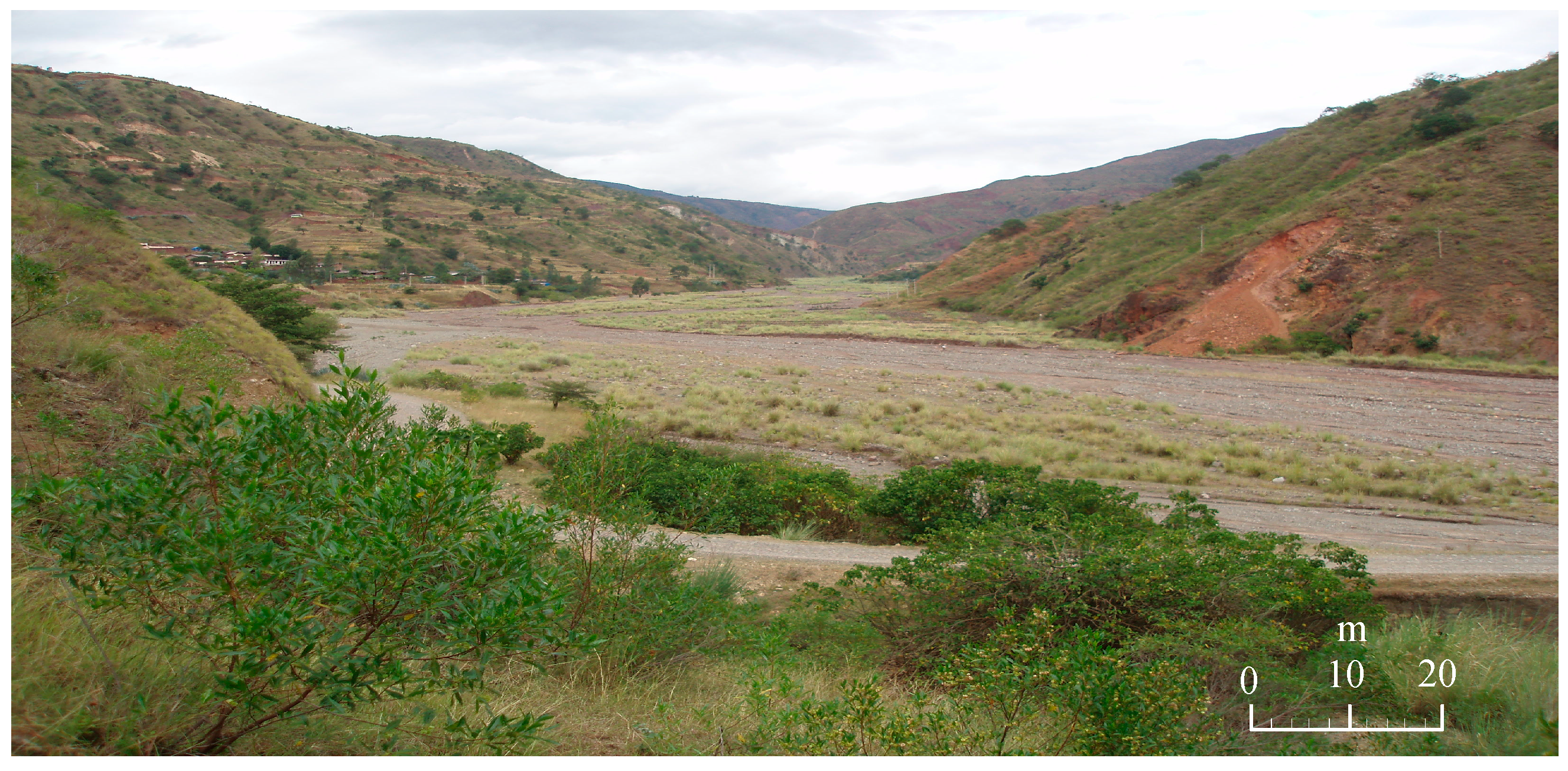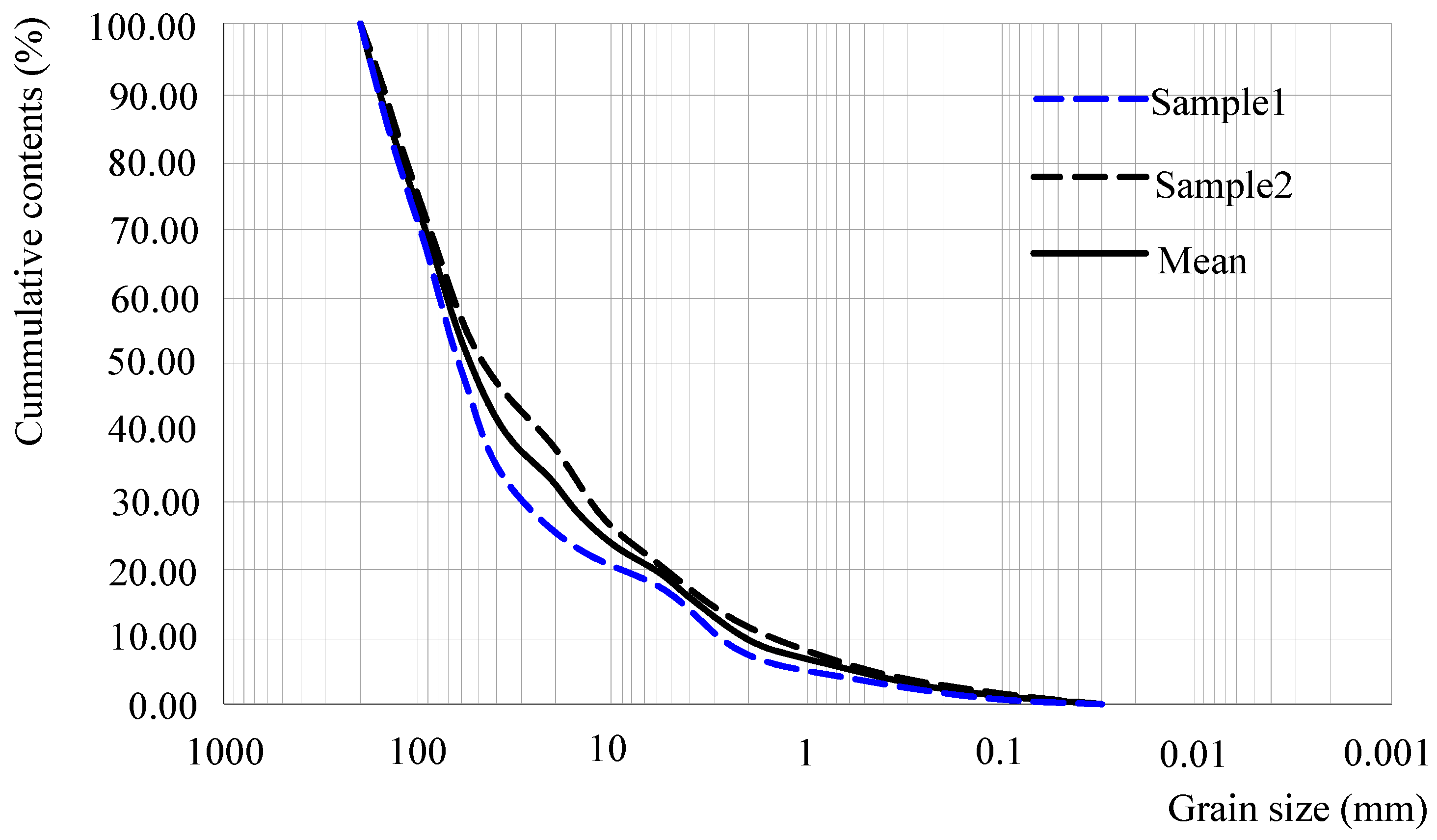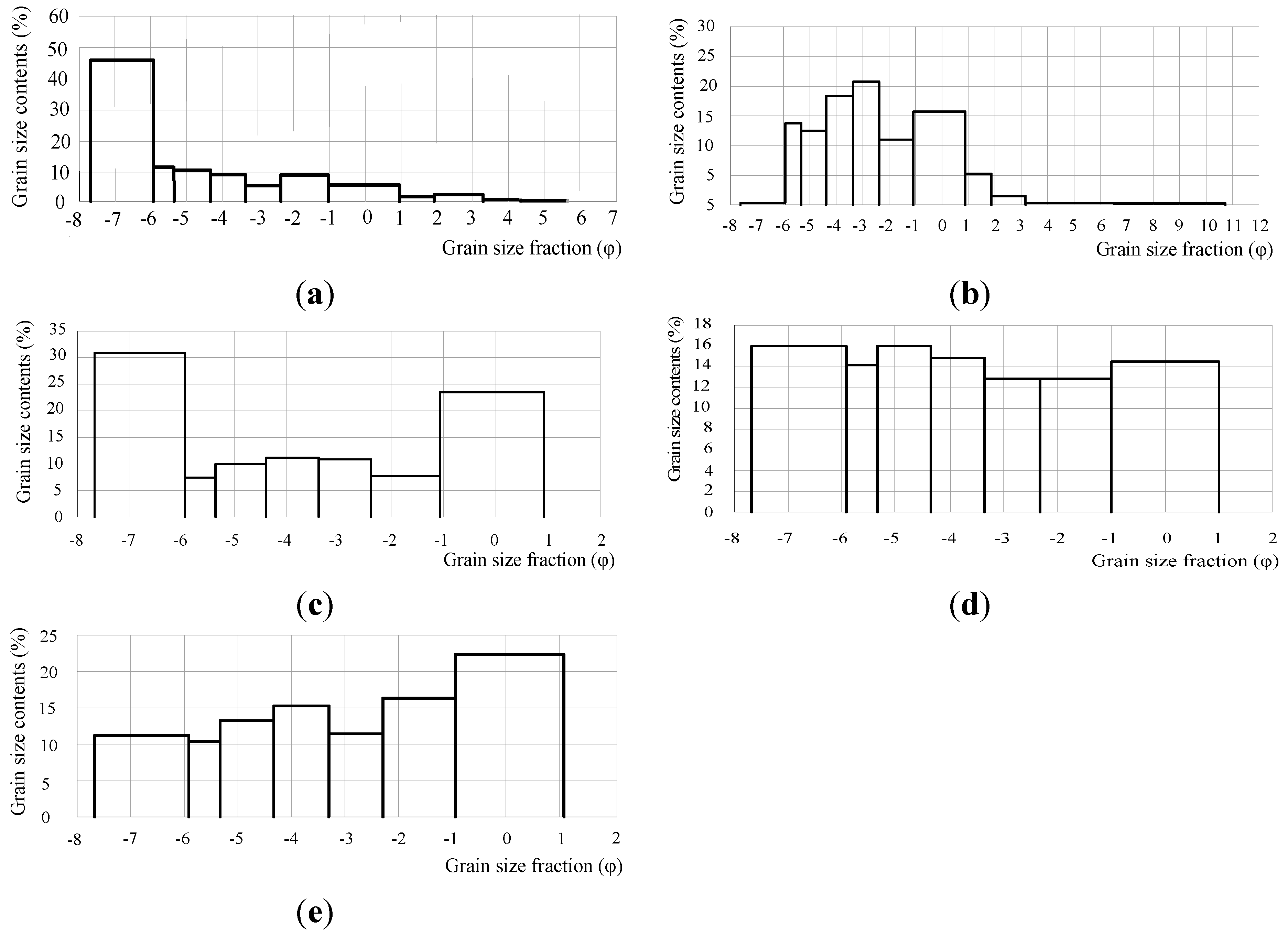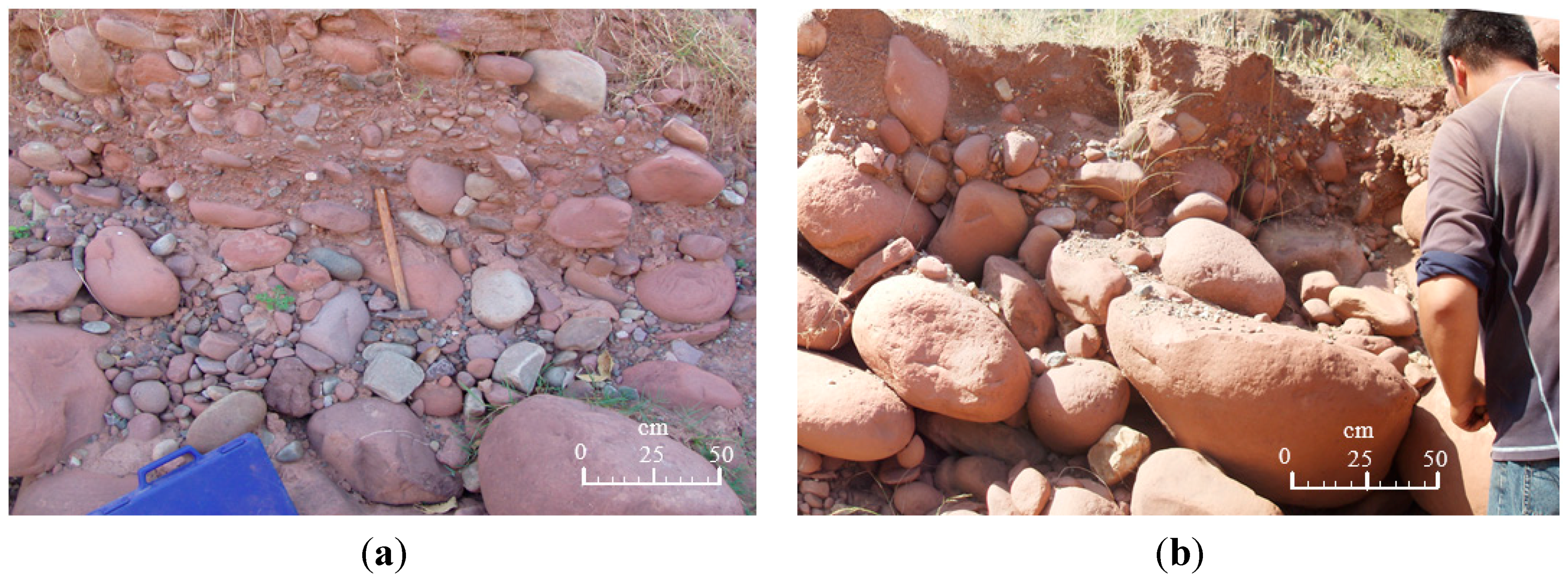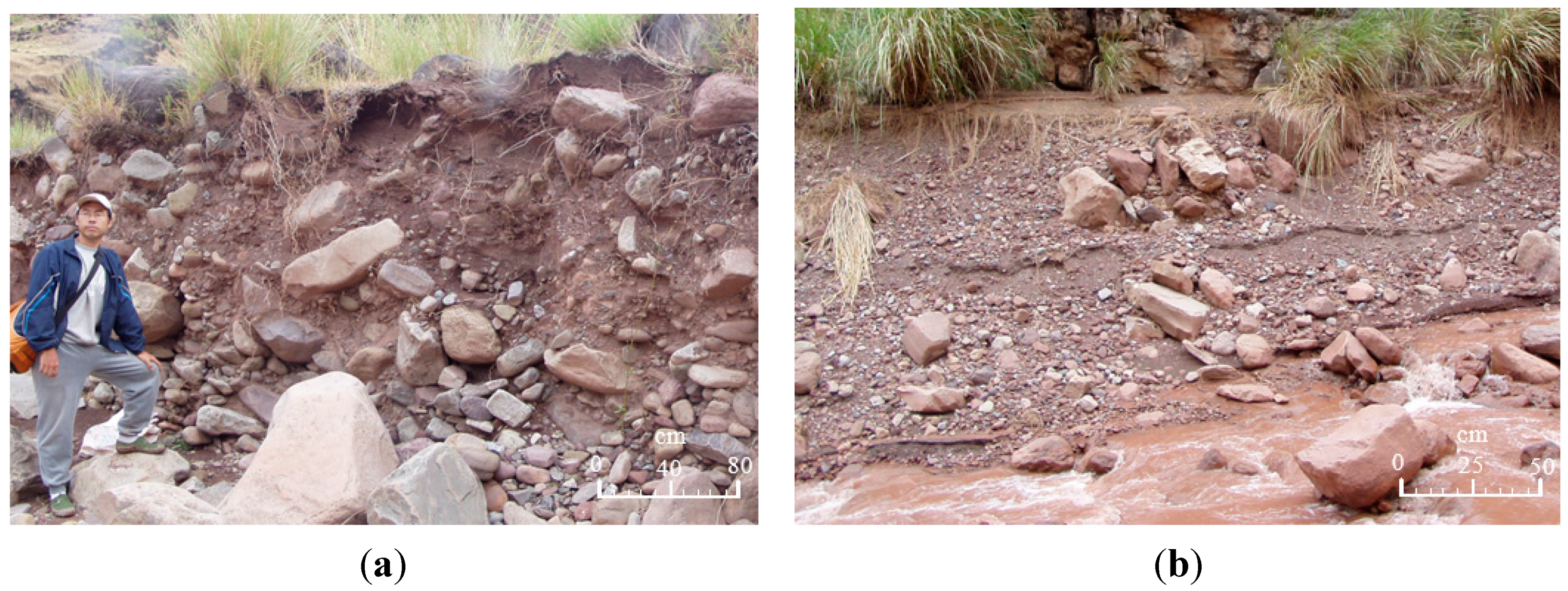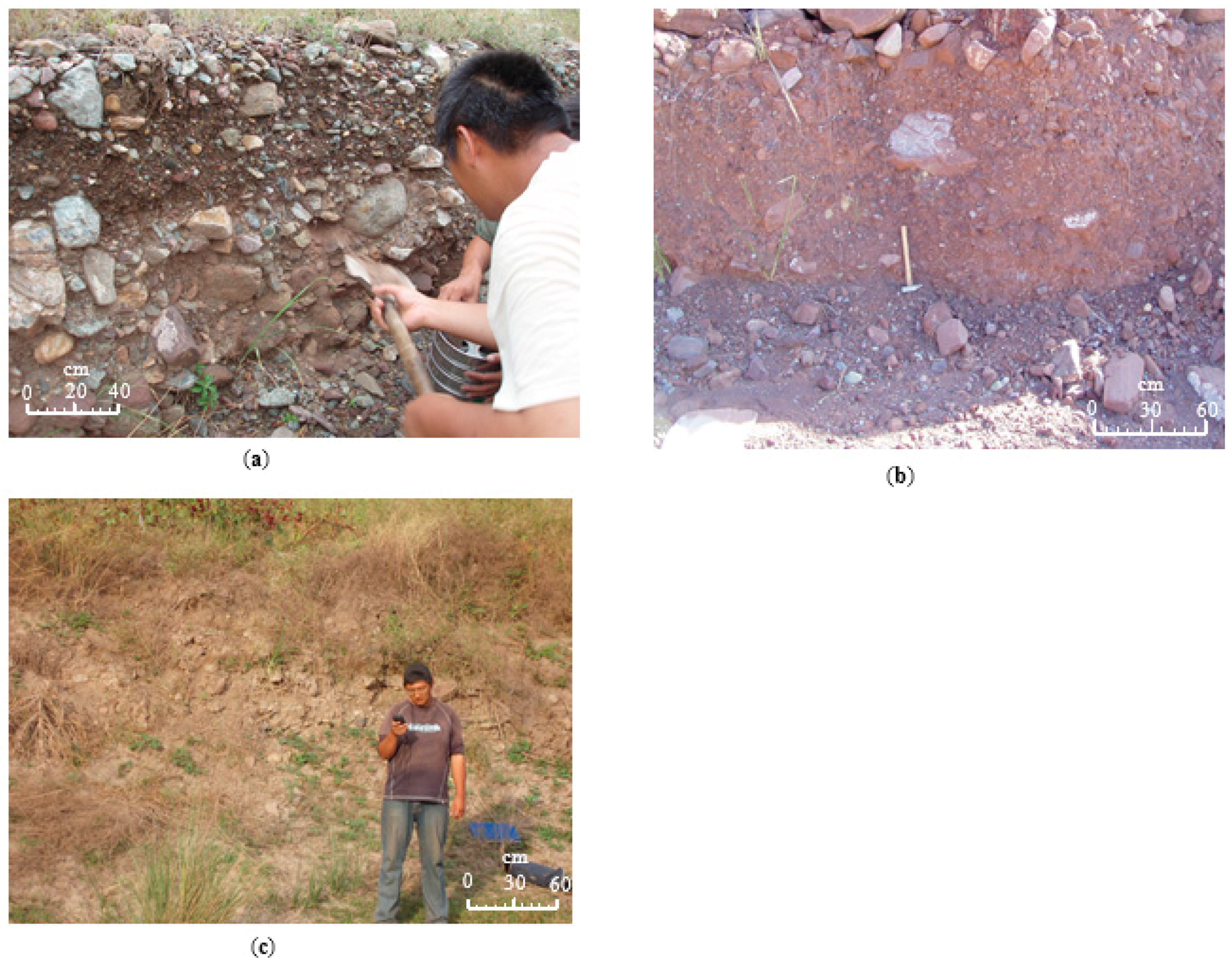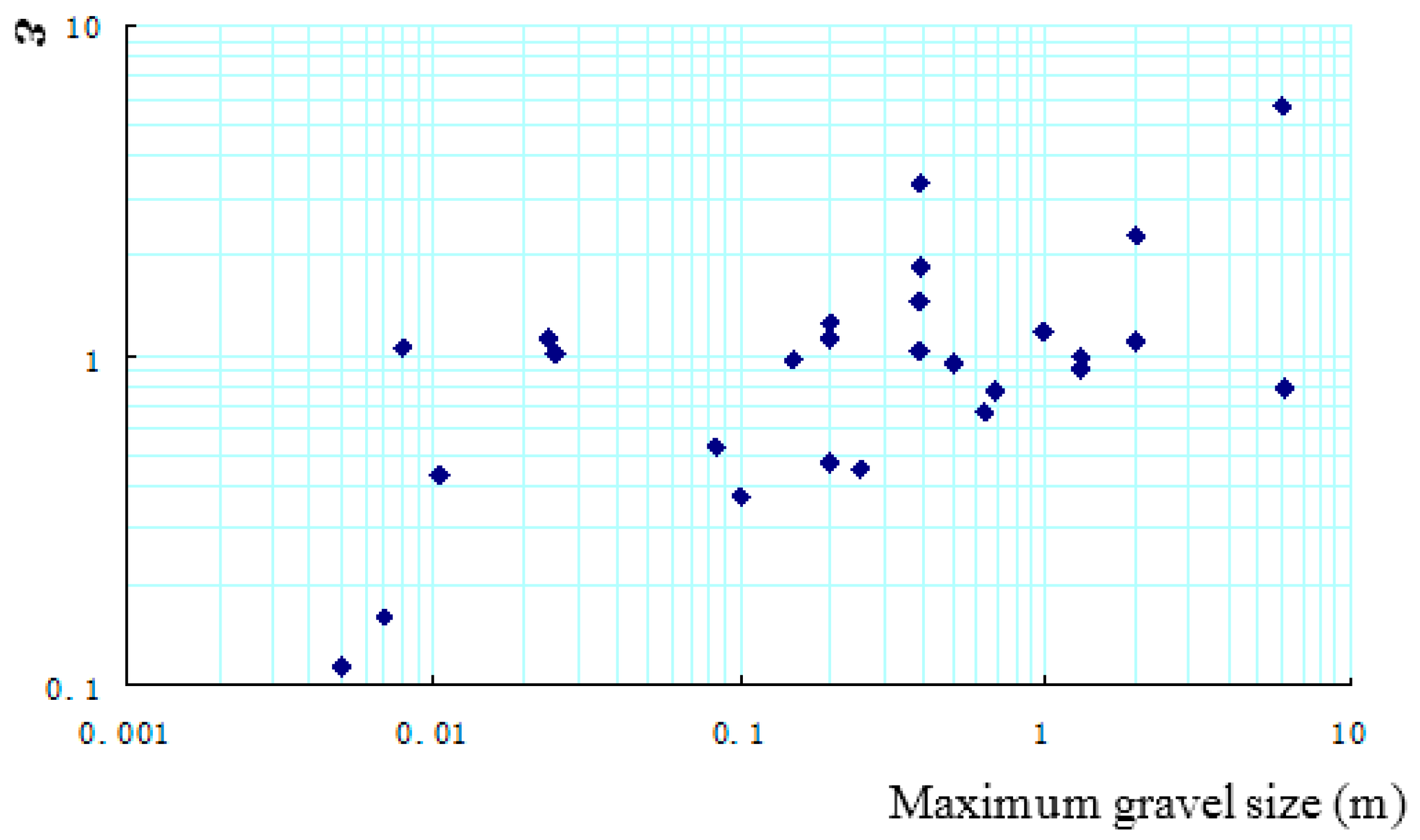The solid-carrying capacity from the initiation to the deposition zones is influenced by various factors in which the grain-size distribution is a very important feature and is analyzed in this study.
4.1. Data Collection
In situ sieve analysis provides a very convenient method for analyzing debris flows. Gully walls can be found on accumulation fans. Most of the gully walls are higher than 1 m; therefore, taking samples from the gully walls is relatively very easy. A set of sieves with sizes of 2, 5, 10, 20, 40, and 60 mm was used.
The smallest sieve size was 2 mm, meaning that particles smaller than 2 mm could not be quantified in situ. Under natural conditions, particles smaller than 2 mm could not be sufficiently dried easily, and some particles were in a pseudo-silty grain form. Samples with grain sizes smaller than 2 mm were taken to the laboratory, and further particle size analyses were performed using both small aperture sieves and the hydrometer method. Thus, the grain-size distribution curves with sizes of 0.075 mm to 60 mm were obtained.
Conducting size analysis for grains larger than 60 mm is impossible using only standard sampling and sieving procedures. Therefore, image analysis described by Tiranti
et al. [
26] was used to determine the size distribution of the large grains. Their study properly scaled and measured the images, and suitable scaled photos were taken of the sampling points. Consequently, the proportions of the grains larger than 60 mm visible in the images were estimated. Despite the problems inherent in reliably estimating the grain diameter (errors resulting from two-dimensional analysis), the image analysis provided a more feasible method than sieve analysis.
More than 10 kg of samples were required for the in situ test, and at least two repetitions of the tests were performed. Portable electronic scales with size of 230 × 230 mm and measuring range of 0.01 kg to 40 kg were used for weighting. Data obtained with the aforementioned methods were then compared and integrated.
4.2. Parametric Study
To describe the characteristics of the debris-flow materials, the modified φ value method [
27] is recommended, applying Equation (1) to perform the grain-size conversion:
where
d is the grain size (mm).
Figure 8, which shows the grain size and the cumulative percentage content of the Yanshuijin deposition, was drawn in terms of Equation (1). The abscissa, which represents the grain size, has a logarithmic scale. Some of the significant indices can be obtained from
Figure 8, such as φ
5, φ
16, φ
25, φ
50, φ
75, φ
84, and φ
95; the subscripts represent the cumulative percentage content.
Table 2 shows the corresponding values of
d and φ. A histogram of the grain-size distribution relative to the φ value can be drawn (
Figure 9).
Table 2.
Corresponding values of d and φ.
Table 2.
Corresponding values of d and φ.
| d (mm) | 0.005 | 0.01 | 0.05 | 0.1 | 0.25 | 0.5 | 2.0 | 5.0 | 10.0 | 20.0 | 40.0 | 60.0 | 200.0 |
|---|
| φ | 7.67 | 6.67 | 4.34 | 3.33 | 2.01 | 1.00 | −1.0 | −2.33 | −3.33 | −4.34 | −5.34 | −5.93 | −7.67 |
Figure 8.
Grain-size distribution of the Yanshuijin sediment.
Figure 8.
Grain-size distribution of the Yanshuijin sediment.
Figure 9.
Histogram of the grain-size distribution of the Yanshuijin deposition.
Figure 9.
Histogram of the grain-size distribution of the Yanshuijin deposition.
To analyze the sedimentary transport environment and the characteristics of the debris-flow materials, the grain size parameter method suggested by Folk and Word [
28] was used. The mean grain size
M is expressed by Equation (2):
When the grain sizes follow a normal distribution, the mean, median, and modal grain diameters reflect the distribution center and the kinetic energy of the sediment. The mean grain size and the mean gain diameter of the Yanshuijin deposition were equal to –5 and 30 mm, respectively.
The standard deviation shows the degree of variation from the mean. A low standard deviation indicates that the data points tend to be close to the mean, whereas high standard deviation indicates that the data are spread out over a large range of values. In this study, the standard deviation σ is expressed by Equation (3):
The standard deviation, which expresses the degree of sorting of the deposition, is 2.60 in the Yanshuijin deposition (calculated by Equation (3)).The degree of sorting can be checked from
Table 3, which is proposed by Folk and Word [
28].
Table 3 shows the degree of sorting for the Yanshuijin deposition is very poor.
Table 3.
Gradation standard of the degree of sorting according to σ.
Table 3.
Gradation standard of the degree of sorting according to σ.
| Degree of Sorting | Extremely Good | Good | Fair | Medium | Poor | Very Poor | Extremely Poor |
|---|
| σ | <0.35 | 0.35–0.5 | 0.5–0.71 | 0.71–1 | 1–2 | 2–4 | >4 |
The coefficient of skewness is a measure of the degree of asymmetry in a distribution. In this study, the coefficient of skewness
Sk is expressed by Equation (4):
The coefficient of skewness expresses the degree of symmetry of fine particles and coarse grains in the distribution curve relative to the location of the modal value. The sample from Yanshuijin contains mainly coarse grains; thus, the location of the modal value is skewed to the coarse-grain side (
i.e., positively skewed). Most river sedimentation and turbidite fan materials belong from the range of positive to extremely positive skewness. The coefficient of skewness of the Yanshuijin deposition was 0.53, as calculated by Equation (4).The skewness gradation (
Table 4) was recommended by Folk and Word [
28]. The gradation of the Yanshuijin deposition materials is extremely positively skewed.
Table 4.
Skewness gradation of the sedimentation.
Table 4.
Skewness gradation of the sedimentation.
| Skewness | Extremely Negative | Negative | Symmetrical | Positive | Extremely Positive |
|---|
| SK | [−1.00, −0.3) | [−0.3, −0.1) | [−0.1, +0.1) | [+0.1, +0.3) | [+0.3, +1.0) |
The coefficient of kurtosis is a measure of the degree of peakedness/flatness in a distribution. In this study, the coefficient of kurtosis
Kg is expressed by Equation (5):
The coefficient of kurtosis is related to the type of source material and the sedimentation environment. A smaller coefficient of kurtosis indicates a wider. The kurtosis gradation (
Table 5) was recommended by Folk and Word [
28]. The coefficient of kurtosis for the Yanshuijin deposition is 1.10, which indicates medium to narrow and sharp forms of the curve (
Table 5).
Table 5.
Kurtosis gradation of sedimentation.
Table 5.
Kurtosis gradation of sedimentation.
| Kurtosis | Very Wide & Gentle | Wide & Gentle | Medium | Narrow &Sharp | Very Narrow &Sharp | Extremely Narrow & Sharp |
|---|
| Kg | <0.67 | 0.67–0.90 | 0.90–1.11 | 1.11–1.56 | 1.56–3.00 | >3.00 |
The values calculated from Equations (2)–(5) show that the mean grain diameter is 30 mm, the degree of sorting is very poor, the histogram is extremely positively skewed to the coarse-grain side and the kurtosis has from medium to narrow and sharp forms.
4.3. Classification of Debris Flows
Figure 8 and
Figure 9 show the cumulative percentage content gradation curves and histograms. Identifying differences between the debris flows by their cumulative percentage content curves is difficult. However, distinguishing the different debris flows using the histograms of the grain-size distributions is relatively straightforward. The five histogram types were summarized by comparing the different histograms (
Table 6).
Table 6.
Features and gradations of the five types of debris flows.
Table 6.
Features and gradations of the five types of debris flows.
| Type | I | II | III | IV | V |
|---|
| Main features of fluid dynamics | Coarse grain, plenty of source materials, poor degree of sorting, short transportation distance, strong destructiveness, and large gradient of transportation channel. The histogram has a negative exponential distribution | Middle grain, plenty of source materials, poor degree of sorting, long transportation distance, and strong destructiveness. The histogram has a normal or gamma distribution | Coarse and fine grain, plenty of source materials, very poor degree of sorting, long transportation distance, high viscosity material, and moderate destructiveness. The histogram has a letter “U” shape. | Extremely poor degree of sorting, plenty of source materials, relatively high viscosity material, and lower to moderate destructiveness. The shape of the histogram look like uniform distribution | Fine particles, relatively poor degree of sorting, and very long transportation distance. The histogram has a positive exponential distribution. |
| Debris flow catchment | Shangbaitan, Xiabaitan, Zhugongdi, Menggu, Kuashan, Yanshuijin, Zhili, Pingdi, Mutudahe, Fapa | Yindigou, Xiushuihe, Nuozhami, Mapidi, Zhangmuhe, Hepiao, Jiaoping, Tianfanghe, Jiali, Daqing | Jiachehe, Zhuzhahe, Yajiede, Chenhe, Mengguohe | Hujia | Canyuhe |
By means of the grain size analyses we have carried out, we have classified the studied debris flows into the five groups that are illustrated in
Figure 10 and
Table 6. Type I exhibits a shape of negative exponential density distribution, Type II features a normal or gamma density distribution shape, Type III has a letter U shape, Type IV shows a uniform density distribution shape, and Type V has a positive exponential density distribution shape. The different histogram shapes show different kinetic energy values, loose source material types, and grain-size distributions, among others.
Figure 10.
(a) A grain size distribution for debris flow Type I; (b) A grain size distribution for debris flow Type II; (c) A grain size distribution for debris flow Type III; (d) A grain size distribution for debris flow Type IV; (e) A grain size distribution for debris flow Type V. Five types of grain size distributions for debris flow materials.
Figure 10.
(a) A grain size distribution for debris flow Type I; (b) A grain size distribution for debris flow Type II; (c) A grain size distribution for debris flow Type III; (d) A grain size distribution for debris flow Type IV; (e) A grain size distribution for debris flow Type V. Five types of grain size distributions for debris flow materials.
We have examined the degree of sorting of the deposits and because the larger the sorting, the larger the travel distance of the flows [
29,
30], we have included in
Table 6 the potential travel distance that the flows would have had without entering the Jinsha river. However, the correlation we obtain where the mobility of the flows increases as the grain size decreases is confirmed by laboratory experiments [
31] and numerical simulations [
32].
A grain index is recommended by the author to describe the characteristics of the debris-flow materials. The grain index ε is defined by Equation (6):
where ε has a positive correlation with the mean grain size, standard deviation, and coefficient of skewness and has a negative correlation with the coefficient of kurtosis. A larger mean grain size (
M) indicates the flow can carry a larger amount of sediment. A greater standard deviation indicates a poorer degree of sorting and a shorter transportation distance. A greater coefficient of skewness indicates a larger grain diameter. A greater coefficient of kurtosis indicates a narrower and sharper curve shape, which represents a better degree of sorting, longer transportation distance, and the less sediment the flow can carry. The flow with high transport energy can carry different sized gravels, which results in a large σ and a small
Kg. Only the flow with a high velocity can carry large sized of gravels. A great proportion of large gravels result in large
SK and
M. Therefore, ε reflects the information on the debris flow transport (kinetic) energy, which represents the ability to carry poorly sorted sediment, especially large gravels. However, it is not strictly equal to the transport energy value stored in the debris flow. The value of the grain index for each debris flow was calculated by Equation (6) and is shown in Column 8 in
Table 7.
Table 7.
Grain index and normalized grain index for the 27 debris flow catchments.
Table 7.
Grain index and normalized grain index for the 27 debris flow catchments.
| Type | Debris Flow Catchment | M 1 | D 2 (mm) | σ 3 | Sk 4 | Kg 5 | ε 6 | S 7 | δ 8 |
|---|
| I | Xiabaitan | −5.03 | 32.28 | 2.19 | 0.40 | 1.04 | 27.19 | 3.1 | 8.77 |
| Shangbaitan | −4.96 | 30.76 | 2.28 | 0.39 | 1.18 | 23.18 | 0.91 | 25.47 |
| Zhugongdi | −4.91 | 29.72 | 2.07 | 0.27 | 0.93 | 17.86 | 6.5 | 2.75 |
| Menggu | −4.80 | 27.54 | 2.08 | 0.41 | 1.26 | 18.64 | 37.1 | 0.50 |
| Kuashan | −4.68 | 25.35 | 2.41 | 0.40 | 0.88 | 27.77 | 6.66 | 4.17 |
| Yanshuijin | −4.95 | 30.55 | 2.60 | 0.53 | 1.10 | 38.27 | 48.58 | 0.79 |
| Zhili | −5.03 | 32.28 | 2.04 | 0.34 | 1.11 | 20.17 | 120.6 | 0.16 |
| Pingdi | −4.62 | 24.32 | 2.40 | 0.40 | 1.14 | 20.48 | 24.2 | 0.85 |
| Mutudahe | −4.68 | 25.35 | 2.61 | 0.43 | 1.31 | 21.72 | 98 | 0.22 |
| Fapa | −4.76 | 26.79 | 2.03 | 0.32 | 1.11 | 15.68 | 24.1 | 0.65 |
| II | Yindigou | −3.63 | 12.27 | 2.23 | 0.18 | 0.71 | 6.94 | 60.5 | 0.11 |
| Xiushuihe | −4.11 | 17.10 | 2.12 | 0.38 | 0.95 | 14.50 | 8.58 | 1.69 |
| Nuozhami | −3.93 | 15.10 | 2.01 | 0.15 | 0.93 | 4.90 | 32.61 | 0.15 |
| Mapidi | −3.53 | 11.46 | 2.65 | 0.30 | 1.01 | 9.02 | 7.2 | 1.25 |
| Zhangmuhe | −3.49 | 11.14 | 1.82 | 0.15 | 0.70 | 4.35 | 4.62 | 0.94 |
| Hepiao | −3.70 | 12.88 | 2.04 | 0.24 | 0.96 | 6.57 | 9.1 | 0.72 |
| Jiaoping | −4.50 | 22.39 | 1.67 | 0.32 | 1.41 | 8.48 | 46.9 | 0.18 |
| Tianfanghe | −4.06 | 16.52 | 2.37 | 0.51 | 1.42 | 14.06 | 13.1 | 1.07 |
| Jiali | −4.36 | 20.32 | 2.12 | 0.34 | 1.00 | 14.65 | 18.9 | 0.78 |
| Daqing | −4.05 | 16.41 | 2.61 | 0.44 | 1.26 | 14.95 | 31.8 | 0.47 |
| III | Jiachehe | −3.79 | 13.71 | 2.84 | 0.38 | 0.94 | 15.74 | 15.6 | 1.01 |
| Zhuzhahe | −4.44 | 21.48 | 3.23 | 0.64 | 0.84 | 52.85 | 152.6 | 0.35 |
| Yajiede | −4.06 | 16.52 | 2.81 | 0.46 | 0.97 | 22.01 | 22.3 | 0.99 |
| Chenhe | −4.34 | 20.04 | 2.26 | 0.30 | 0.99 | 13.73 | 590 | 0.02 |
| Mengguohe | −4.95 | 30.55 | 2.05 | 0.39 | 1.33 | 18.36 | 620.8 | 0.03 |
| IV | Hujia | −3.77 | 13.52 | 2.46 | 0.24 | 1.05 | 7.60 | 8.62 | 0.88 |
| V | Canyuhe | −3.11 | 8.57 | 2.62 | 0.15 | 0.94 | 3.58 | 256 | 0.01 |
Table 6 shows the grain size data for each debris flow catchment investigated
in situ. Both Types I and II have ten debris flows, Type III has five debris flows, and Types IV and V have only one debris flow each.
